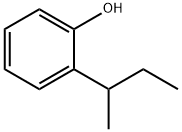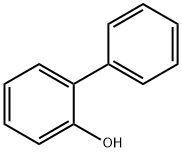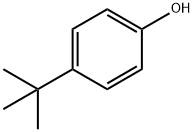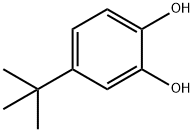2-sec-Butylphenol
- CAS NO.:89-72-5
- Empirical Formula: C10H14O
- Molecular Weight: 150.22
- MDL number: MFCD00002225
- EINECS: 201-933-8
- SAFETY DATA SHEET (SDS)
- Update Date: 2025-09-25 17:15:13

What is 2-sec-Butylphenol?
Chemical properties
colourless to light yellow liquid
Chemical properties
The butylphenols include several isomers. Solid butylphenols (28805-86-9) generally have properties similar to the above:
The Uses of 2-sec-Butylphenol
Chemical intermediate in preparation of resins, plasticizers, surface-active agents.
The Uses of 2-sec-Butylphenol
Herbicide, Insecticide, Polymerization Inhibitor, Stabilizer Intermediate
The Uses of 2-sec-Butylphenol
A chemical intermediate in the production of resins, plasticizers, and other products
Definition
ChEBI: A member of the class of phenols that is phenol carrying a butan-2-yl group at position 2.
General Description
Clear colorless liquid.
Air & Water Reactions
Insoluble in water.
Reactivity Profile
Phenols, such as 2-sec-Butylphenol, do not behave as organic alcohols, as one might guess from the presence of a hydroxyl (-OH) group in their structure. Instead, they react as weak organic acids. Phenols and cresols are much weaker as acids than common carboxylic acids (phenol has Ka = 1.3 x 10^[-10]). These materials are incompatible with strong reducing substances such as hydrides, nitrides, alkali metals, and sulfides. Flammable gas (H2) is often generated, and the heat of the reaction may ignite the gas. Heat is also generated by the acid-base reaction between phenols and bases. Such heating may initiate polymerization of the organic compound. Phenols are sulfonated very readily (for example, by concentrated sulfuric acid at room temperature). The reactions generate heat. Phenols are also nitrated very rapidly, even by dilute nitric acid.
Hazard
Skin, eye, and upper respiratory tract irri- tant.
Health Hazard
o-sec-Butylphenol is a skin, eye,
and respiratory irritant.
Acute occupational exposures have resulted
in mild respiratory irritation as well as
skin burns.
Fire Hazard
2-sec-Butylphenol is combustible.
Flammability and Explosibility
Not classified
Safety Profile
A poison by intraperitoneal and intravenous routes. Moderately toxic by ingestion and skin contact. A severe skin and eye irritant. Combustible when exposed to heat or flame. To fight fire, use foam, spray, CO2, dry chemical. When heated to decomposition it emits acrid and irritating fumes. See also PHENOL and other butyl phenols
Potential Exposure
Butylphenols may be used as intermediates in manufacturing varnish and lacquer resins; as a germicidal agent in detergent disinfectants; as a pour point depressant, in motor-oil additives; de-emulsifier for oil; soap-antioxidant, plasticizer, fumigant, and insecticide
Shipping
UN2430 Alkylphenols, solid, n.o.s. (including C2-C12 homologues), Hazard class: 8; Labels: 8— Corrosive material
Incompatibilities
Vapors may form explosive mixture with air. These phenol/cresol materials can react with oxidizers; reaction may be violent. Incompatible with strong reducing substances such as hydrides, nitrides, alkali metals, and sulfides. Flammable gas (H2) is often generated, and the heat of the reaction may cause the gas to ignite and explode. Heat is also generated by the acid-base reaction with bases; such heating may initiate polymerization of the organic compound. React with boranes, alkalies, aliphatic amines, amides, nitric acid, sulfuric acid. Phenols are sulfonated very readily (for example, by concentrated sulfuric acid at room temperature). These reactions generate heat. Phenols are also nitrated very rapidly, even by dilute nitric acid and can explode when heated. Many phenols form metal salts that may be detonated by mild shock
Properties of 2-sec-Butylphenol
| Melting point: | 12 °C(lit.) |
| Boiling point: | 226-228 °C(lit.) |
| Density | 0.982 g/mL at 25 °C(lit.) |
| vapor pressure | 0.03 mm Hg ( 20 °C) |
| refractive index | n |
| Flash point: | 234 °F |
| form | Liquid |
| pka | 10.36±0.35(Predicted) |
| color | White to Light yellow |
| Water Solubility | Insoluble. <0.1 g/100 mL at 20 ºC |
| BRN | 1210026 |
| Exposure limits | ACGIH: TWA 5 ppm (Skin) NIOSH: TWA 5 ppm(30 mg/m3) |
| Stability: | Stable, but air sensitive. Incompatible with acid chlorides, acid anhydrides, bases, strong oxidizing agents, copper and its alloys, brass. |
| CAS DataBase Reference | 89-72-5(CAS DataBase Reference) |
| NIST Chemistry Reference | Phenol, 2-(1-methylpropyl)-(89-72-5) |
| EPA Substance Registry System | o-sec-Butylphenol (89-72-5) |
Safety information for 2-sec-Butylphenol
| Signal word | Danger |
| Pictogram(s) |
 Corrosion Corrosives GHS05  Exclamation Mark Irritant GHS07 |
| GHS Hazard Statements |
H302:Acute toxicity,oral H314:Skin corrosion/irritation |
| Precautionary Statement Codes |
P270:Do not eat, drink or smoke when using this product. P280:Wear protective gloves/protective clothing/eye protection/face protection. P301+P312:IF SWALLOWED: call a POISON CENTER or doctor/physician IF you feel unwell. P303+P361+P353:IF ON SKIN (or hair): Remove/Take off Immediately all contaminated clothing. Rinse SKIN with water/shower. P305+P351+P338:IF IN EYES: Rinse cautiously with water for several minutes. Remove contact lenses, if present and easy to do. Continuerinsing. |
Computed Descriptors for 2-sec-Butylphenol
New Products
Indole Methyl Resin tert-butyl 9-methoxy-3-azaspiro[5.5]undecane-3-carboxylate Boc-His(Boc)-OH 2-CTC Resin 4-Chloro-7-tosy1-7Hpyrrolo[2,3-d]pyrimidine 5,7-Dibromo-1H-indole 2,5-dichloro-N-hydroxy-4,6-dimethylpyridine-3-carboximidamide 2,2-Dimethoxy-7-azaspiro[3.5]nonane hydrochloride 4-chloromethyl-5-methyl-1,3-dioxol-2-one (DMDO-Cl) R-2-BENZYLOXY PROPIONIC ACID 1,1’-CARBONYLDIIMIDAZOLE 1,1’-CARBONYLDI (1,2-4 TRIAZOLE) N-METHYL INDAZOLE-3-CARBOXYLIC ACID 4-((2-hydroxyethyl)thio)benzoic acid 1-(TERT-BUTOXYCARBONYL)-2-PYRROLIDINONE Methyl 6-methylnicotinate 3-Pyridineacrylic acid tert-Butyl carbazate TETRAHYDRO-2H-PYRAN-3-OL 2-((4-morpholinophenylamino) (methylthio) methylene) malononitrile 3-(4-morpholinophenylamino)-5-amino-1H-pyrazole-4-carbonitrile 2,4-dihydroxybenzaldehyde 1,3-Diethyl-1,3-Diphenylurea Methyl 2-methylquinoline-6-carboxylateRelated products of tetrahydrofuran








You may like
-
 2-sec-Butylphenol CAS 89-72-5View Details
2-sec-Butylphenol CAS 89-72-5View Details
89-72-5 -
 2-sec-Butylphenol CAS 89-72-5View Details
2-sec-Butylphenol CAS 89-72-5View Details
89-72-5 -
 Pyridine 99.5% HPLC /UV SpectroscopyView Details
Pyridine 99.5% HPLC /UV SpectroscopyView Details
110-86-1 -
 Piperazine Spot supply, best priceView Details
Piperazine Spot supply, best priceView Details
110-85-0 -
 Dibutyl PhthalateView Details
Dibutyl PhthalateView Details
84-74-2 -
 Imidazole Spot supply, competitive priceView Details
Imidazole Spot supply, competitive priceView Details
288-32-4 -
 Octadecyl 3-(3,5-di-tert-butyl-4-hydroxyphenyl)propionate 98% (GC)View Details
Octadecyl 3-(3,5-di-tert-butyl-4-hydroxyphenyl)propionate 98% (GC)View Details
2082-79-3 -
 Thiourea 99% ARView Details
Thiourea 99% ARView Details
62-56-6
